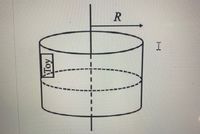
An Introduction to Physical Science
14th Edition
ISBN: 9781305079137
Author: James Shipman, Jerry D. Wilson, Charles A. Higgins, Omar Torres
Publisher: Cengage Learning
expand_more
expand_more
format_list_bulleted
Concept explainers
Question
Below is a sketch of the toy on a rotor ride at the moment after the floor drops. The rotor has a radius of R and the toy has mass m. Assume the
write Newton’s Second Law for the x and y directions.
Use algebra and your equations above to predict the minimum angular velocity ωmin necessary to keep the toy “stuck” to the side of the rotation tube. Express your answer in terms of g, μs, R. (nonumbers yet). Show all of your work and your final result below.

Transcribed Image Text:R
Toy
Expert Solution
This question has been solved!
Explore an expertly crafted, step-by-step solution for a thorough understanding of key concepts.
This is a popular solution
Trending nowThis is a popular solution!
Step by stepSolved in 2 steps with 1 images

Knowledge Booster
Learn more about
Need a deep-dive on the concept behind this application? Look no further. Learn more about this topic, physics and related others by exploring similar questions and additional content below.Similar questions
- What is the last thing you should do when solving a problem? Explain.arrow_forwardCheck Your Understanding Suppose that Balto in Example 2.10 leaves the game to attend to more important matter, but Astro Clifford and Dug continue playing. Astro and Clifford’s pull on the toy does not change, but Dug rims around and bites on the toy in a different place. With how big a force and in what direction must Dug pull on the toy now to balance out the combined pulls from Clifford and Astro? Illustrate this situation by drawing a vector diagram indicating all forces involved.arrow_forwardIf vectors A and B are orthogonal, what is the component of B along the direction of A ? What Is the component of A along the direction of B ?arrow_forward
- What is the dot product of a vector with the cross product that this vector has with another vector?arrow_forwardCheck Your Understanding Light navels about 9 Pm in a year. Given that a year is about 3107s , what is the speed of light in meters per second?arrow_forwardMount Everest, at 29,028ft , is the tallest mountain on Earth. What is its height in kilometers? (Assume that 1m=3.281ft .)arrow_forward
- Starting at the island of Moi in an unknown archipelago, a fishing boat makes a round trip with two stops at the islands of Noi and Poi. It sails from Moi for 4.76 nautical miles (nmi) in a direction 37 north of east to Noi. From Noi, it sails 69 west of north to Poi. On its return leg from Poi, it sails 28 east of south. What distance does the boat sail between Noi and Poi? What distance does it sail between Moi and Poi? Express your answer both in nautical miles and in kilometei. Note: 1 nmi = 1852m.arrow_forwardWhat do vectors and scalars have in common? How do they differ?arrow_forwardThe CERN particle accelerator is circular with a circumference of 7.0 km. (a) What is the acceleration of the protons (m=1.671027kg)that move around the accelerator at 5of the speed of light? (The speed of light is v=3.00108m/s .) (b) What is the force on the protons?arrow_forward
- What is needed to designate a position?arrow_forwardOne mile is equal to 1,609 m. Express this distance in kilometers and in centimeters.arrow_forwardAn object is dropped from a roof of a building of height h . During the last second of its descent, it drops a distance h/3 . Calculate the height of the building.arrow_forward
arrow_back_ios
SEE MORE QUESTIONS
arrow_forward_ios
Recommended textbooks for you
 An Introduction to Physical SciencePhysicsISBN:9781305079137Author:James Shipman, Jerry D. Wilson, Charles A. Higgins, Omar TorresPublisher:Cengage Learning
An Introduction to Physical SciencePhysicsISBN:9781305079137Author:James Shipman, Jerry D. Wilson, Charles A. Higgins, Omar TorresPublisher:Cengage Learning College PhysicsPhysicsISBN:9781938168000Author:Paul Peter Urone, Roger HinrichsPublisher:OpenStax College
College PhysicsPhysicsISBN:9781938168000Author:Paul Peter Urone, Roger HinrichsPublisher:OpenStax College Glencoe Physics: Principles and Problems, Student...PhysicsISBN:9780078807213Author:Paul W. ZitzewitzPublisher:Glencoe/McGraw-Hill
Glencoe Physics: Principles and Problems, Student...PhysicsISBN:9780078807213Author:Paul W. ZitzewitzPublisher:Glencoe/McGraw-Hill University Physics Volume 1PhysicsISBN:9781938168277Author:William Moebs, Samuel J. Ling, Jeff SannyPublisher:OpenStax - Rice University
University Physics Volume 1PhysicsISBN:9781938168277Author:William Moebs, Samuel J. Ling, Jeff SannyPublisher:OpenStax - Rice University
 Principles of Physics: A Calculus-Based TextPhysicsISBN:9781133104261Author:Raymond A. Serway, John W. JewettPublisher:Cengage Learning
Principles of Physics: A Calculus-Based TextPhysicsISBN:9781133104261Author:Raymond A. Serway, John W. JewettPublisher:Cengage Learning

An Introduction to Physical Science
Physics
ISBN:9781305079137
Author:James Shipman, Jerry D. Wilson, Charles A. Higgins, Omar Torres
Publisher:Cengage Learning

College Physics
Physics
ISBN:9781938168000
Author:Paul Peter Urone, Roger Hinrichs
Publisher:OpenStax College

Glencoe Physics: Principles and Problems, Student...
Physics
ISBN:9780078807213
Author:Paul W. Zitzewitz
Publisher:Glencoe/McGraw-Hill

University Physics Volume 1
Physics
ISBN:9781938168277
Author:William Moebs, Samuel J. Ling, Jeff Sanny
Publisher:OpenStax - Rice University


Principles of Physics: A Calculus-Based Text
Physics
ISBN:9781133104261
Author:Raymond A. Serway, John W. Jewett
Publisher:Cengage Learning